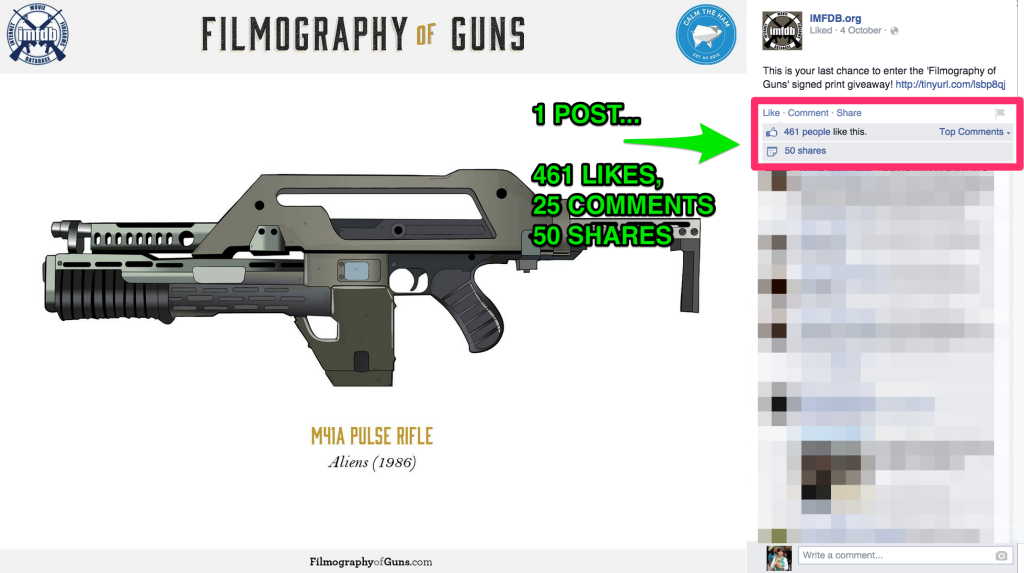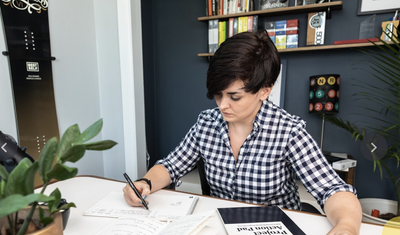
In April I launched the project The Filmography of Aircraft and received $25,161 in funding, which was 838% of my original goal. In September, I launched The Filmography of Guns and received $45,905 in funding, which was 708% of my goal.
So what did I do differently?
Essentially these products were very similar, yet the second project doubled its funding to over $50,000 total (My math isn’t off. I’ll explain soon…)
In a previous post, I wrote about my method of launching a successful Kickstarter campaign, and then later the true costs of a successful Kickstarter project. If you haven’t read these, I would suggest you read them for the full story of then versus now.
Backer Engagement
The behavior of the majority of Kickstarter projects is that it launches, gets pledges during the first 48-72 hours, and then gets quiet.
How do you keep backers engaged?
In the last Kickstarter post I mentioned a strategy to improve in the future would be to run a contest to drive engagement between backers.
I did that this time with the Guns campaign: a film gun tournament wherein every day I put guns against each other in a fun graphic giving people a chance to vote and promote each day. Backers who voted at a $1 level were given voting rights.
By telling backers that I’d be doing something cool with the winning gun, they had a vested interest in making sure it was one they liked.
Toward the end of the campaign, I had over 170 backers voting each day, which is great engagement considering it requires clicking to another site to vote.
Updates, updates… and more updates
I posted many more updates this time to keep in touch with backers, both for the contest updates and to announce new ideas for the Kickstarter. Some of these were personal videos from me which I didn’t do previously (because I really dislike recording videos of myself), and I think this increased trust with backers.
Just look at the difference between The Filmography of Aircraft and The Filmography of Guns. Updates + contest = engagement.

Also since fulfillment isn’t quite complete (should be by the end of this week) there will be a few updates and comments forthcoming.
At the end of the contest, the winning gun was The Walther PPK made famous by James Bond. I gave a signed 8.5″ x 11″ of this gun to all my backers who pledged at higher than a $25 level or higher as a way of showing my appreciation for those who had taken the time to vote.
Joint Venture Opportunities
I reached out to Chris Serrano who runs the Internet Movie Firearm Database and was extremely helpful both during Kickstarter and since. Not only did he proofread the print for errors, but he has also partnered with me as an affiliate for The Filmography of Guns products, and we’re coming up with ideas for future products.
I created a landing page on my store that was created solely for his audience.
I created many images for the contest which were very shareable by nature. By Chris sharing images on his Facebook page which was already highly engaged, I gained a lot of exposure and engagement. In the month of the Kickstarter campaign, I received 535 more likes on our Facebook page.

Takeaway: Partner with people who already serve your target audience. There are endless opportunities, and, if possible, create shareable images for social media to build a following.
Crafting the Perfect Kickstarter Page
Over the past few months, I’ve been working on a free course for Kickstarter and have been researching both successful and unsuccessful projects. I’ve broken down a successful Kickstarter page into 7 key elements;
- The Video
- The Pictures
- The Funding
- The Timeline
- The Rewards
- The Social Proof
- The FAQs.
I’ll explain these elements better in another post.
Now, in regards to the page elements: a picture tells 1000 words. In the image below (click the image below to see), compare my previous campaign page with the most recent one. Do you see a big difference?

Do you see a big difference?
I do. More detailed, more information about rewards, social proof, better images. Basically, I crafted the Kickstarter campaign page as if it were a product itself and it worked.
The Rewards
I priced the rewards slightly higher this time. With Aircraft, I didn’t account (as much as I should have) for the high cost of postage. The base reward that I knew everyone would want would be the print itself.
Last time I priced this reward at $45, whereas this time I had an early bird special for numbered editions 20-119 for $49. This was limited to 100 backers who would get both a price discount and an earlier numbered edition.
By limiting this reward level, I’m building scarcity and people are more likely to back earlier. This reward alone accounted for 13% of the final raised amount, or $5,913, and almost the entire funding goal.

Takeaway: Build scarcity by limiting rewards for early adopters in your project. Give them something special as a reward (e.g., early numbered print editions).
Introduce new rewards
Don’t be afraid to introduce new rewards if people ask – 4 people asking for the same reward means way more people likely want it too but only a few bothered to message you about it.
In my mind, The Filmography of Guns poster print was the main reward everyone would want, and the Collector’s Book reward was a secondary supplement. However, several people wrote asking for just a book reward level which now makes sense.
Some people won’t have any need (or room) for a print with guns on their wall, but they would want a book. I created that reward, and it ended up being one of the most popular tiers and accounted for $6,880 in revenue.
Reward bundles
Do you have backers asking how they add multiple rewards to their pledges? Make it simple for them to do so by bundling products together as one reward.
I don’t like doing math so I’m not going to make my backers do it either. In the image below is a reward bundle I added mid-way through the campaign to keep the engagement going and increase funding.

Press
I emailed many more bloggers than last time as well as different types of bloggers, such as those that ran either design, film, or gun blogs. I essentially used the exact same template shown in this post.
Many of the places I wrote ended up covering the print while other blogs I received coverage from simply shared from those places I did contact and posted the same information.
I also reached out to podcasters who were already serving my target audience and, as a result, appeared as a guest on Pencil Kings, Gun Nation, and Hollywood Guns.

All the links in pink are from emails I personally sent to these blog owners. The press in blue were shared from the articles of the press I contacted… ah yes, the butterfly effect. The top 2 blog referral sources accounted for $3,760 (around 8%) of the total funding.
I used the press I received as social proof (#6 in my perfect Kickstarter page list) which I added to my Kickstarter page to build credibility. As well as this I created a share button which led to a very simple landing page to make it easy for people to quickly share my project on their Facebook and Twitter.

The Fiverr Hack
Ever considered getting press from Fiver? Yes, it’s possible. I got a 5,390% Return on Investment (ROI) from this platform. I spent $10 and ended up getting at least $549 in funding on Kickstarter (I’ll explain the ‘at least’ in the next part).
How did I do it? I went to Fiverr.com and searched for ‘guns’. Most of the results were useless to me, but 1-2 decent ones are all I needed.

I paid $5 for each of these people to post to their gun-related Facebook pages about my project, which was exactly suited to their large audience.
One of them ended up writing a blog post about it since he liked the project so much. From that post, I gained $549 in funding on Kickstarter.
It most likely led to more funding than that, but unfortunately, I can’t put an exact number on it due to limited tracking from Facebook.
So while I can’t track from Facebook exactly if more people pledged from their posts, there’s a very good chance they did. Or at the very least share it via social media.
Takeaway: Don’t limit yourself to the conventional methods of getting eyes on your project. Small hacks like this may be equally as effective in funding on Kickstarter. I wish I had explored it more; however, at the time, I was experimenting and seeing what works.
Backerkit
This is where the extra $5,000 came from that actually doubled my previous Kickstarter funding.
I used Backerkit for this project which I didn’t use last time. My original intention for using was for the more robust survey and tracking capabilities. Due to the add-ons and reward levels, I didn’t think the Kickstarter platform itself would allow for such robust surveys – at least not without me spending many hours in front of a computer.
I know my strengths, and organization and spreadsheets generally aren’t in my basket top skills. Backerkit allows people to increase their rewards and add on new products all at the same Kickstarter prices.
I thought it was a little expensive at first: $608 with 5% off any extra add-ons bought. However, I ended up getting money in extra add-ons from backers, so it turned out to be a great ROI. Also, it meant easily sending tracking information, surveying for future products, etc.

Takeaway: Don’t be afraid of trying something new, it can end up paying off in dividends (literally). Also, value your time. I knew by not using this system I would waste many hours trying to do this myself, and I know there are better things I could be doing.
Never mind the time savings and revenue, I used the surveys to find out what products people wanted from me next. It’s a lot easier to decide what’s next when you have a backer wishlist of products and email addresses for each.
And that’s how I did it… again. I made some major improvements from last time, gained some new fans from Kickstarter, and made contact with a few people who are now working with me on collaborations for new projects. I’m definitely happy I returned to Kickstarter for this project for these reasons alone.
Become a subscriber receive the latest updates in your inbox.





